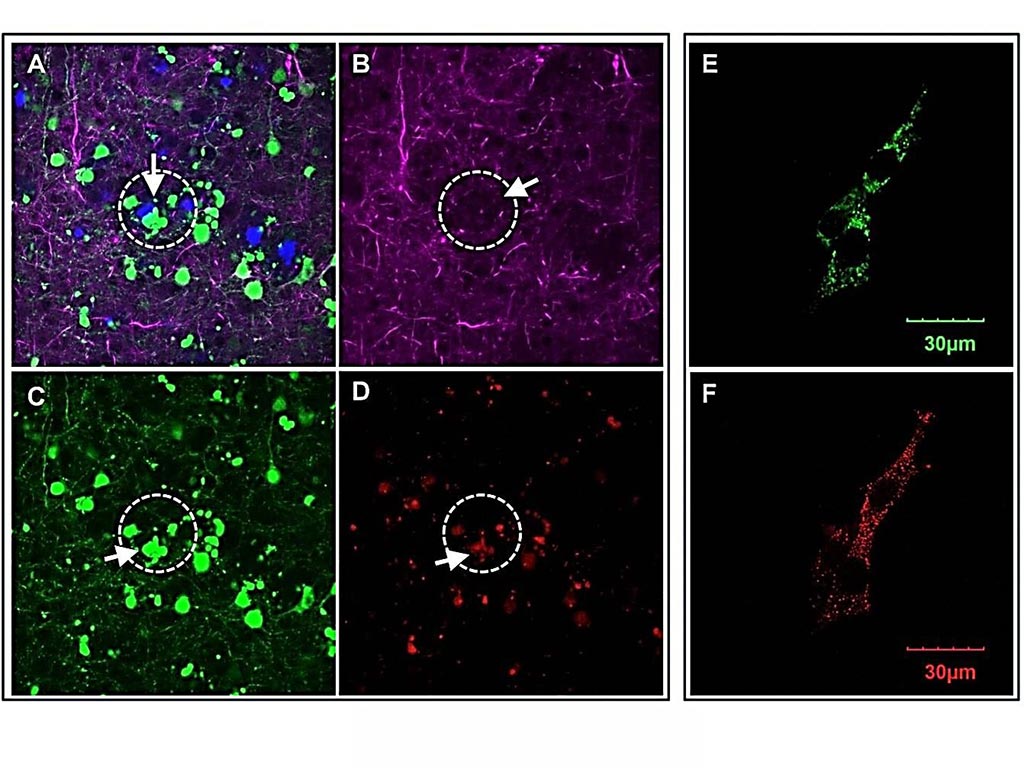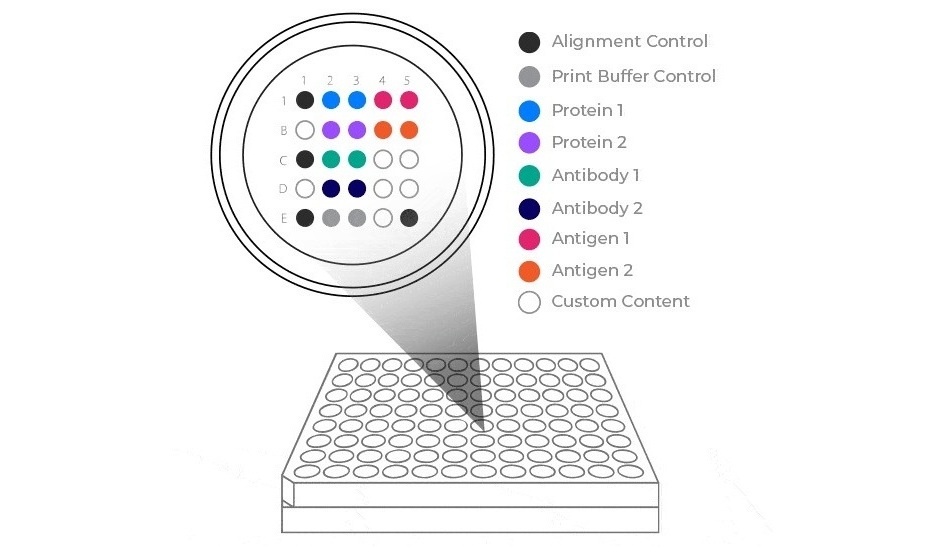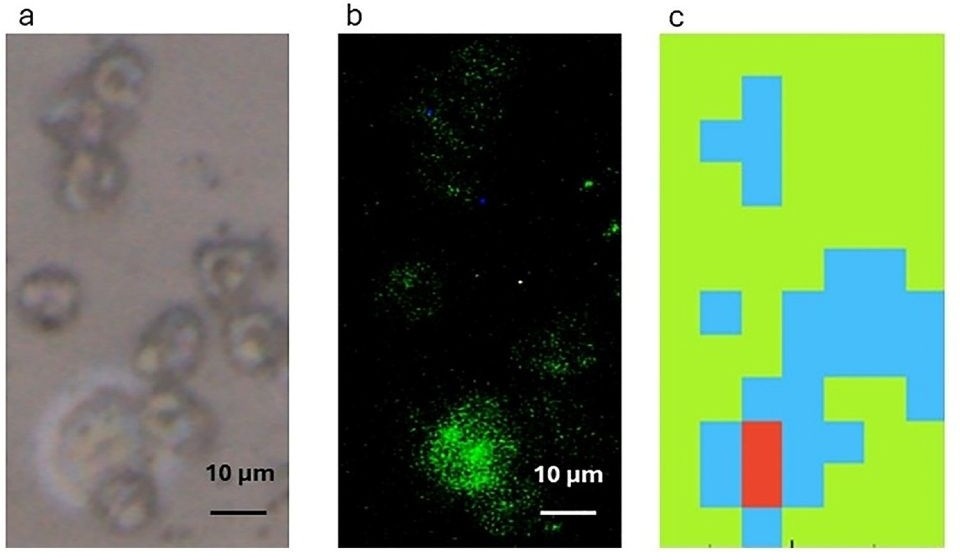Ovarian Cancer Protein Contributes to Alzheimer`s Disease Neurodegeneration
|
By LabMedica International staff writers Posted on 30 Jan 2020 |

Image: In the brain of mice with Alzheimer\'s, areas near amyloid plaques (A) appear with fewer neural networks (B), dying neurons (C) and higher OCIAD1 (D). In cultured neuronal cells, the OCIAD1 proteins (E) appear in the mitochondria (F) (Photo courtesy of Houston Methodist Research Institute).
Alzheimer's disease is a complex neurological disorder with pathological hallmarks of hyperamyloidosis (senile plaques), neurofibrillary tangles containing hyperphosphorylated tau, and extensive neurodegeneration in the brain.
Alzheimer's disease (AD) pathogenesis remains elusive and no effective therapy is available. Neurodegeneration, including synaptic damage and neuronal loss, forms the basis of dementia in AD, and certain brain regions are more vulnerable during disease progression.
Scientists at the Houston Methodist Research Institute (Houston, TX, USA) and their colleagues reported on a new role of ovarian cancer immune-reactive antigen domain containing 1 (OCIAD1). Originally discovered for its effect on ovarian cancer metastasis and stem cell metabolisms, the group found the OCIAD1 protein in human brain cells, and determined it impairs neurons and damages synapses in the brain, contributing to neurodegeneration in Alzheimer's disease.
The investigators culled through archived bioinformatics data of brain tissue from deceased Alzheimer's patients, as well as mouse models by blending computational methods with laboratory studies. They determined that OCIAD1 plays a role in the disease's progressive neurodegeneration by impairing mitochondria function. Known as the powerhouse of cells, damage to mitochondria results in the trickle-down cell death effect in the brain leading to neuron damage.
Higher levels of OCIAD1, found in vulnerable brain areas and dystrophic neurites, were correlated with disease severity. Multiple early AD pathological events, particularly Aβ/GSK-3β signaling, elevated OCIAD1, which in turn interacts with BCL-2 to impair mitochondrial function and facilitates mitochondria-associated neuronal injury. Notably, elevated OCIAD1 by Aβ increases cell susceptibility to other AD pathological challenges.
Xuping Li, PhD, an instructor of Neurodegeneration in Oncology and co-corresponding author, said, “We applied a system biology strategy to see if we could find a different mechanism of neurodegeneration in Alzheimer's disease. We identified OCIAD1 as a new neurodegeneration-relevant factor, predicted its function, and demonstrated it mediates the long-term impact of amyloid beta on cells and synaptic damages by impairing mitochondria function.” The study was published on January 12, 2020 in the journal EBioMedicine.
Related Links:
Houston Methodist Research Institute
Alzheimer's disease (AD) pathogenesis remains elusive and no effective therapy is available. Neurodegeneration, including synaptic damage and neuronal loss, forms the basis of dementia in AD, and certain brain regions are more vulnerable during disease progression.
Scientists at the Houston Methodist Research Institute (Houston, TX, USA) and their colleagues reported on a new role of ovarian cancer immune-reactive antigen domain containing 1 (OCIAD1). Originally discovered for its effect on ovarian cancer metastasis and stem cell metabolisms, the group found the OCIAD1 protein in human brain cells, and determined it impairs neurons and damages synapses in the brain, contributing to neurodegeneration in Alzheimer's disease.
The investigators culled through archived bioinformatics data of brain tissue from deceased Alzheimer's patients, as well as mouse models by blending computational methods with laboratory studies. They determined that OCIAD1 plays a role in the disease's progressive neurodegeneration by impairing mitochondria function. Known as the powerhouse of cells, damage to mitochondria results in the trickle-down cell death effect in the brain leading to neuron damage.
Higher levels of OCIAD1, found in vulnerable brain areas and dystrophic neurites, were correlated with disease severity. Multiple early AD pathological events, particularly Aβ/GSK-3β signaling, elevated OCIAD1, which in turn interacts with BCL-2 to impair mitochondrial function and facilitates mitochondria-associated neuronal injury. Notably, elevated OCIAD1 by Aβ increases cell susceptibility to other AD pathological challenges.
Xuping Li, PhD, an instructor of Neurodegeneration in Oncology and co-corresponding author, said, “We applied a system biology strategy to see if we could find a different mechanism of neurodegeneration in Alzheimer's disease. We identified OCIAD1 as a new neurodegeneration-relevant factor, predicted its function, and demonstrated it mediates the long-term impact of amyloid beta on cells and synaptic damages by impairing mitochondria function.” The study was published on January 12, 2020 in the journal EBioMedicine.
Related Links:
Houston Methodist Research Institute
Latest Pathology News
- Genetics and AI Improve Diagnosis of Aortic Stenosis
- AI Tool Simultaneously Identifies Genetic Mutations and Disease Type
- Rapid Low-Cost Tests Can Prevent Child Deaths from Contaminated Medicinal Syrups
- Tumor Signals in Saliva and Blood Enable Non-Invasive Monitoring of Head and Neck Cancer
- Common Health Issues Can Influence New Blood Tests for Alzheimer’s Disease
- Blood Test Formula Identifies Chronic Liver Disease Patients with Higher Cancer Risk
- Tunable Cell-Sorting Device Holds Potential for Multiple Biomedical Applications
- AI Tool Outperforms Doctors in Spotting Blood Cell Abnormalities
- AI Tool Rapidly Analyzes Complex Cancer Images for Personalized Treatment
- Diagnostic Technology Performs Rapid Biofluid Analysis Using Single Droplet
- Novel Technology Tracks Hidden Cancer Cells Faster
- AI Tool Improves Breast Cancer Detection
- AI Tool Predicts Treatment Success in Rectal Cancer Patients
- Blood Test and Sputum Analysis Predict Acute COPD Exacerbation
- AI Tool to Transform Skin Cancer Detection with Near-Perfect Accuracy
- Unique Immune Signatures Distinguish Rare Autoimmune Condition from Multiple Sclerosis
Channels
Molecular Diagnostics
view channel
Multiplex Antibody Assay Could Transform Hepatitis B Immunity Testing
Hepatitis B remains a major global health challenge, yet immunity testing has historically been constrained by cost, operational complexity, and single-analyte approaches. Now, a multiplex antibody assay... Read more
Genetic Testing Improves Comprehensive Risk-Based Screening for Breast Cancer
Breast cancer screening has long relied on age-based guidelines, assuming similar risk across all women despite clear evidence that individual risk varies widely. This one-size-fits-all approach can lead... Read more
Urine Test Could Reveal Real Age and Life Span
Chronological age does not always reflect how quickly the body is aging, as biological age is shaped by genetics, stress, sleep, nutrition, and lifestyle factors such as smoking. A higher biological age... Read more
Genomic Test Identifies African Americans at Risk for Early Prostate Cancer Recurrence
Prostate cancer is one of the most commonly diagnosed cancers in men and a leading cause of cancer-related death, particularly in the United States. African American men face a disproportionately higher... Read moreHematology
view channel
MRD Tests Could Predict Survival in Leukemia Patients
Acute myeloid leukemia is an aggressive blood cancer that disrupts normal blood cell production and often relapses even after intensive treatment. Clinicians currently lack early, reliable markers to predict... Read more
Platelet Activity Blood Test in Middle Age Could Identify Early Alzheimer’s Risk
Early detection of Alzheimer’s disease remains one of the biggest unmet needs in neurology, particularly because the biological changes underlying the disorder begin decades before memory symptoms appear.... Read more
Microvesicles Measurement Could Detect Vascular Injury in Sickle Cell Disease Patients
Assessing disease severity in sickle cell disease (SCD) remains challenging, especially when trying to predict hemolysis, vascular injury, and risk of complications such as vaso-occlusive crises.... Read more
ADLM’s New Coagulation Testing Guidance to Improve Care for Patients on Blood Thinners
Direct oral anticoagulants (DOACs) are one of the most common types of blood thinners. Patients take them to prevent a host of complications that could arise from blood clotting, including stroke, deep... Read moreImmunology
view channel
Ultrasensitive Liquid Biopsy Demonstrates Efficacy in Predicting Immunotherapy Response
Immunotherapy has transformed cancer treatment, but only a small proportion of patients experience lasting benefit, with response rates often remaining between 10% and 20%. Clinicians currently lack reliable... Read more
Blood Test Could Identify Colon Cancer Patients to Benefit from NSAIDs
Colon cancer remains a major cause of cancer-related illness, with many patients facing relapse even after surgery and chemotherapy. Up to 40% of people with stage III disease experience recurrence, highlighting... Read moreMicrobiology
view channel
New UTI Diagnosis Method Delivers Antibiotic Resistance Results 24 Hours Earlier
Urinary tract infections affect around 152 million people every year, making them one of the most common bacterial infections worldwide. In routine medical practice, diagnosis often relies on rapid urine... Read more
Breakthroughs in Microbial Analysis to Enhance Disease Prediction
Microorganisms shape human health, ecosystems, and the planet’s climate, yet identifying them and understanding how they are related remains a major scientific challenge. Even with modern DNA sequencing,... Read morePathology
view channel
Genetics and AI Improve Diagnosis of Aortic Stenosis
Aortic stenosis is a progressive narrowing of the aortic valve that restricts blood flow from the heart and can be fatal if left untreated. There are currently no medical therapies that can prevent or... Read more
AI Tool Simultaneously Identifies Genetic Mutations and Disease Type
Interpreting genetic test results remains a major challenge in modern medicine, particularly for rare and complex diseases. While existing tools can indicate whether a genetic mutation is harmful, they... Read more
Rapid Low-Cost Tests Can Prevent Child Deaths from Contaminated Medicinal Syrups
Medicinal syrups contaminated with toxic chemicals have caused the deaths of hundreds of children worldwide, exposing a critical gap in how these products are tested before reaching patients.... Read more
Tumor Signals in Saliva and Blood Enable Non-Invasive Monitoring of Head and Neck Cancer
Head and neck cancers are among the most aggressive malignancies worldwide, with nearly 900,000 new cases diagnosed each year. Monitoring these cancers for recurrence or relapse typically relies on tissue... Read moreTechnology
view channel
Pioneering Blood Test Detects Lung Cancer Using Infrared Imaging
Detecting cancer early and tracking how it responds to treatment remains a major challenge, particularly when cancer cells are present in extremely low numbers in the bloodstream. Circulating tumor cells... Read more
AI Predicts Colorectal Cancer Survival Using Clinical and Molecular Features
Colorectal cancer is one of the most common and deadly cancers worldwide, and accurately predicting patient survival remains a major clinical challenge. Traditional prognostic tools often rely on either... Read moreIndustry
view channel
BD and Penn Institute Collaborate to Advance Immunotherapy through Flow Cytometry
BD (Becton, Dickinson and Company, Franklin Lakes, NJ, USA) has entered into a strategic collaboration with the Institute for Immunology and Immune Health (I3H, Philadelphia, PA, USA) at the University... Read more

















